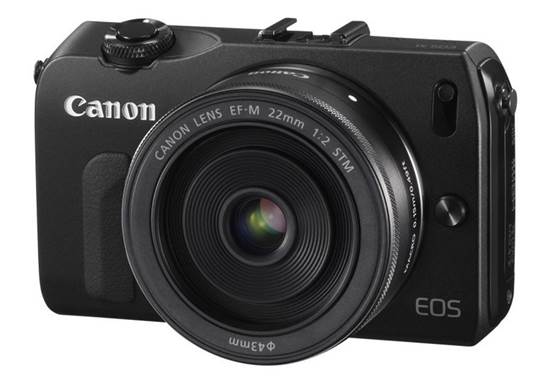Powerful image quality as you would find
from a compact camera, but the autofocus issues and labor efficiency has
compromised itself.
So far Canon has resisted the appeal of the
midway stop, waiting longer than 4 years compared with rivals such as Panasonic
to supply a mirror-less camera with the interchangeable lenses. Is it right
that time has been spent wisely by waiting for the others smashed barriers
before appearing with a market-leading product?

Canon
EOS M is priced at $671 with 18-55mm kit lens.
The initial signs proved to be promising.
Canon offered a new lens system for EOS M, along with a mount adapter (around
$167 including VAT) that allows Canon DLSR owners mount EF and current EF-S
lenses. The new lenses - an 18-55mm kit lens and a 22mm pancake prime - with
the sturdy metal barrels, which are better than the plastic kit lenses that
Canon offered with the recent DSLR.
EOS M uses the touch screen control system
that is similar to the system that was originally introduced with the EOS 650D.
It allows you to navigate menus, adjust the settings and even select focus
points and shoot without pressing a physical button. That's good, because the
compact body of the EOS M has less room for normal buttons.
The shutter /mode switch buttons and on /
off buttons are the only controls you will find at the top of the camera,
whereas the rear only has four buttons (Movie Record, Menu, Info and Playback),
with four-direction pad with the digital disk surrounding it to rotate the settings
while shooting.

The
shutter /mode switch buttons and on / off buttons are the only controls you
will find at the top of the camera.
Overall, the touch screen controls are
temporarily sufficient, with the icons and menus are large enough to allow you
to access to the main settings easily. However, in the creative modes, they
allow you to use the screen to shoot; we often take pictures by mistake when we
are adjusting a setting. If anyone needs a picture of the middle-age person’s
foot, we had a lot.
Our main complaint towards safe and
effective design of the camera is related to handling. There is very little
room to put your finger on the left barrel of the lens, and the right grip is
too small to hold the camera with one hand confidently, we usually grip it in
awkward ways, like grasping it.
The shooting modes include all of ones you
would find on a consumer-level DSLR camera, which consist of the aperture
priority / shutter speed, full manual and many presets. However, the autofocus
performance proved to be erratic. With kit lens attached, it was usually unable
to lock objects, especially in low light conditions, with a 75-300mm zoom lens
attached to the lens adapter, it really struggled. Hybrid auto / manual focus
modes eliminate this problem to some extent, allowing you to tweak if the
autofocus becomes limited. However, it is too erratic for us to like.

With
kit lens attached, it was usually unable to lock objects, especially in low
light conditions, with a 75-300mm zoom lens attached to the lens adapter, it
really struggled.
That's a defame because when the focus
showed sharpness, the shots on the sensor of 18MP APS-C of EOS M are as good as
the ones created by Canon's consumer-level DSLR - though that does not make a
surprise , based on this is the same sensor you will find in the 650D EOS.
The retained details are immaculate,
especially when using the 22mm pancake lens at a close distance. The colors are
accurate and there is a good balance; and the EOS M exposures the contrast
scenes very well. In the automatic mode, the camera tends to increase ISO up to
noise levels ominously (6,400 and up) rather than decrease the shutter speeds,
but the images can be saved, as long as you shoot in the raw mode and have
decent editing software.
The EOS M works well in the daylight, but
has no electronic viewfinder - even if there is no option to add it to the hot-shoe
- means that you are relying on the screen under the sunlight. You can hardly
see the image whether is in the proper focus mode or not. Hotshoe can be used
for attached Speedlite 90EX; a mini flash provides the performance just for
emergencies like any built-in flash.
The EOS M also records video at Full HD
resolutions; and it's hard to find the faults with the scenes. Although the
autofocus sometimes fails, the new lenses do not generate noise which damages
the footages. The exposure is excellent, with the options of manual controls
completely via the touch screen. There is also a 3.5mm jack for attaching an
external mic. The anti-vibration system in the 18-55mm kit lens does not work
very well, so you should keep your tripod nearby if you want to have the
pro-level scenes.
We are torn by EOS M. If you are looking
for a pocket-able camera that will provide the better images than the ones you
can expect from a normal compact camera, it is worth for your careful
consideration. Yes, the struggling autofocus and the inconvenient handling make
it miss a recommended award. Canon has reserved much time before entering this
market - we believe that there is a missing piece to put it into the
competition for the A-List.
Info
·
Price: $671with 18-55mm kit lens
Ratings
·
Total: 4/6
·
Image Quality: 5/6
·
Features and design: 4/6
·
Value: 4/6
|
Canon EOS M
Basic Technical Specifications
·
An 18MP APS-C sensor
·
A 1,040pixel 3-inch screen
·
An 18-55mm f/3.5-5.6 EF-M kit lens, 4.3fps
shooting mode
·
A SDXC slot
·
A one- year RTB warranty
·
109x33x68.5mm (WHD)
·
294g (496g with the kit lens)
|